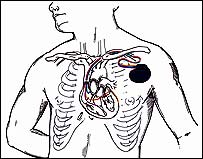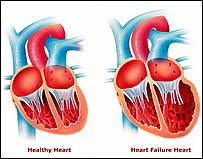|
|
New Pacemaker 'Saves Lives'
BBC News Online
May 19, 2004

The pacemaker stimulates both major heart chambers
Patients with long-term heart failure could have their life expectancy improved by a new type of pacemaker.
A US study which followed 1,500 patients found those who had a device implanted were less likely to be admitted to hospital, or to die.
Around 900,000 people in the UK are thought to be living with long-term heart failure.
The research, led by the University of Colorado, is published in the New England Journal of Medicine. This evidence should stimulate the wider use of this treatment in carefully selected patients. All our hearts beat with the help of electrical impulses. In a healthy organ these impulses trigger a smooth rhythm which enables the heart to pump blood efficiently around our bodies. However, in some patients with heart failure damage to the muscles of heart prevents electrical signals moving around the organ as they should.
This knocks the rhythm of the heart out of kilter, so that instead of beating simultaneously, its two major chambers - known as the ventricles - beat slightly out of phase.
This reduces the heart's ability to pump blood out into the body with sufficient force.
The new generation of pacemakers can help to re-synchronise the contractions of the heart by stimulating the ventricles simultaneously.
The technique is known as cardiac-resynchronization therapy. It differs from typical pacemakers, which pace only the right ventricle.
Big impact

The device is implanted under the shoulder and connected to the heart through wires.
The researchers found it reduced the likelihood of death from all causes by up to 36%, as well as bringing down hospital admissions.
The best results were achieved when the pacemaker was combined with a defibrillator - an electronic device used to establish normal heartbeat.
The technology is relatively new, and each device costs around £20,000.
The National Institute for Clinical Excellence is to decide whether it represents a cost-effective treatment for the NHS - but not until 2006.
Professor John Camm, Professor of Clinical Cardiology, St. George's Hospital Medical School, London, said: "The results clearly demonstrate that CRT has the potential to bring about very substantial health and economic benefits to patients and the NHS.
"However, the UK lags behind other countries in widely adopting this therapy. Clearly, it has an important role to play in the management of heart failure.
"Steps need to be taken to ensure better and more widespread use of this technology."
Professor Philip Poole-Wilson, of the British Heart Foundation, based at Imperial College London, said: "Heart failure is a debilitating disease.
"The trial is the first large, long-term study to show that these new devices reduce admissions to hospital and, when used together, reduce mortality.
"This evidence should stimulate the wider use of this treatment in carefully selected patients."
|
|



